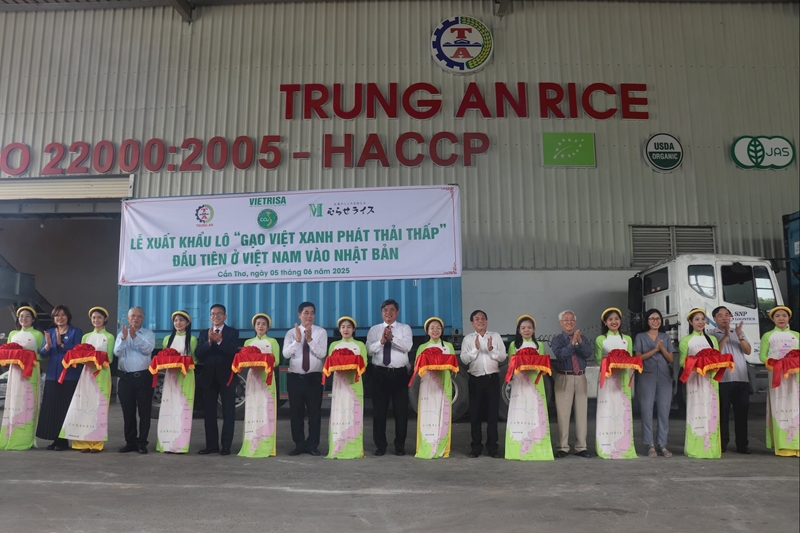A milestone in Vietnam’s green transition
In early June, the first batch of rice bearing the “Low-Emission Green Vietnamese Rice” label departed Can Tho Port for Japan, one of the world’s most demanding markets. The shipment not only marked a new export order but also a significant milestone in the sector’s shift from traditional cultivation to sustainable, low-emission, higher value-added production.
    |
 |
|
Delegates cut the ribbon to mark the export of the first batch of "Low-Emission Green Vietnamese Rice" to the Japanese market on June 5, 2025. |
The VIETRISA, in partnership with Trung An Company, held a ceremony to export the first shipment, the first product under the program to develop one million hectares of high-quality, low-emission rice cultivation associated with green growth in the Mekong Delta to 2030 (the One Million Hectare Program), to reach international markets.
The “Low-Emission Green Vietnamese Rice” label was developed with support from line ministries and international organizations, including the International Rice Research Institute (IRRI), the Netherlands Development Organization (SNV) and the World Bank. The regulations on the use of the label were finalized and issued on April 16, 2025.
The “Low-Emission Green Vietnamese Rice” label is granted by the VIETRISA to rice produced in accordance with the One Million Hectare Program’s technical standards, verified by commune authorities or accredited international organizations. Certified products must ensure clear traceability, covering production area, variety and cropping season, and full compliance with low-emission, high-quality cultivation protocols.
With support from the Netherlands Development Organization, VIETRISA has so far issued label-use certificates to seven enterprises, representing more than 19,200 tons of rice.
The introduction of tens of thousands of tons of rice under this label, including the first shipment to Japan, confirms Vietnam as the first country in the world to place low-emission rice on both domestic and export markets.
Demonstrating Vietnamese rice sector’s commitment to green growth
According to Le Thanh Tung, Secretary-General of VIETRISA, the label is not a commercial brand but a collective label developed by the association. Its purpose is to demonstrate that Vietnamese rice is produced through cost-efficient, low-emission cultivation consistent with the One Million Hectare Program’s sustainable-development orientation.
He underscored two key functions of the label. First, it encourages farmers, cooperatives and businesses to join the program and commit to standardized, eco-friendly practices.
Second, it enables consumers and buyers to recognize products that meet low-emission criteria. Instead of assessing purely technical specifications, they can rely on a visible indicator of environmental compliance.
To date, around 20,000 tons of rice have been certified under the label, including 500 tones shipped to Japan, a market with stringent food-safety requirements. While price differentiation is still developing, the label significantly enhances credibility, environmental value and market positioning, highlighting Vietnam’s determination to green its rice sector.
A strict and transparent certification process
To obtain the “Low-Emission Green Vietnamese Rice” label, enterprises or cooperatives must operate within designated production zones of the One Million Hectare Program, obtain local government confirmation and register before seeding. The cultivation process must follow the Ministry of Agriculture and Environment’s low-emission technical standards and undergo on-site verification.
Currently, VIETRISA is completing procedures to register the label with the Intellectual Property Office and is working with international certifying bodies to evaluate and validate products under recognized low-emission standards, laying the foundation for global protection and recognition.
According to Tung, the One Million Hectare Program has attracted unprecedented engagement from across the sector, from farmers, cooperatives, enterprises, research institutions to local authorities. Beyond technical and economic benefits, the program carries significant socio-economic and political value, supporting Vietnam’s commitment to achieving net-zero emissions by 2050.
From 2025, the program will expand production to build a comprehensive, sustainable rice ecosystem. High-quality, low-emission rice areas will continue to grow, paving the way for a national certification label and, ultimately, a national brand for Low-Carbon Vietnamese Rice, promoting the sector’s growth and enhancing the global reputation of Vietnamese rice.
Approved in November 2023, the program aims to develop one million hectares of high-quality, low-emission rice linked to value-chain restructuring and sustainable cultivation practices. Its objectives include raising value and efficiency, protecting the environment, enhancing climate resilience and reducing greenhouse-gas emissions in line with Vietnam’s international commitments. The program is being implemented across 12 Mekong Delta localities in two phases.
Building on the success of the “Low-Emission Green Vietnamese Rice” label, Vietnam is moving towards establishing a national brand of “Low-Carbon Vietnamese Rice,” further cementing its place on the global agricultural map.
From the first 500 tons of “green” rice to the expanding low-carbon fields of the Mekong Delta, Vietnam is demonstrating its resolve to elevate its longstanding rice sector within the global value chain. “Vietnamese Green Rice” represents not only sustainable agriculture but also the country’s broader ambition to green its economy and secure a prosperous, resilient future for Vietnamese farmers.
Source: VNA